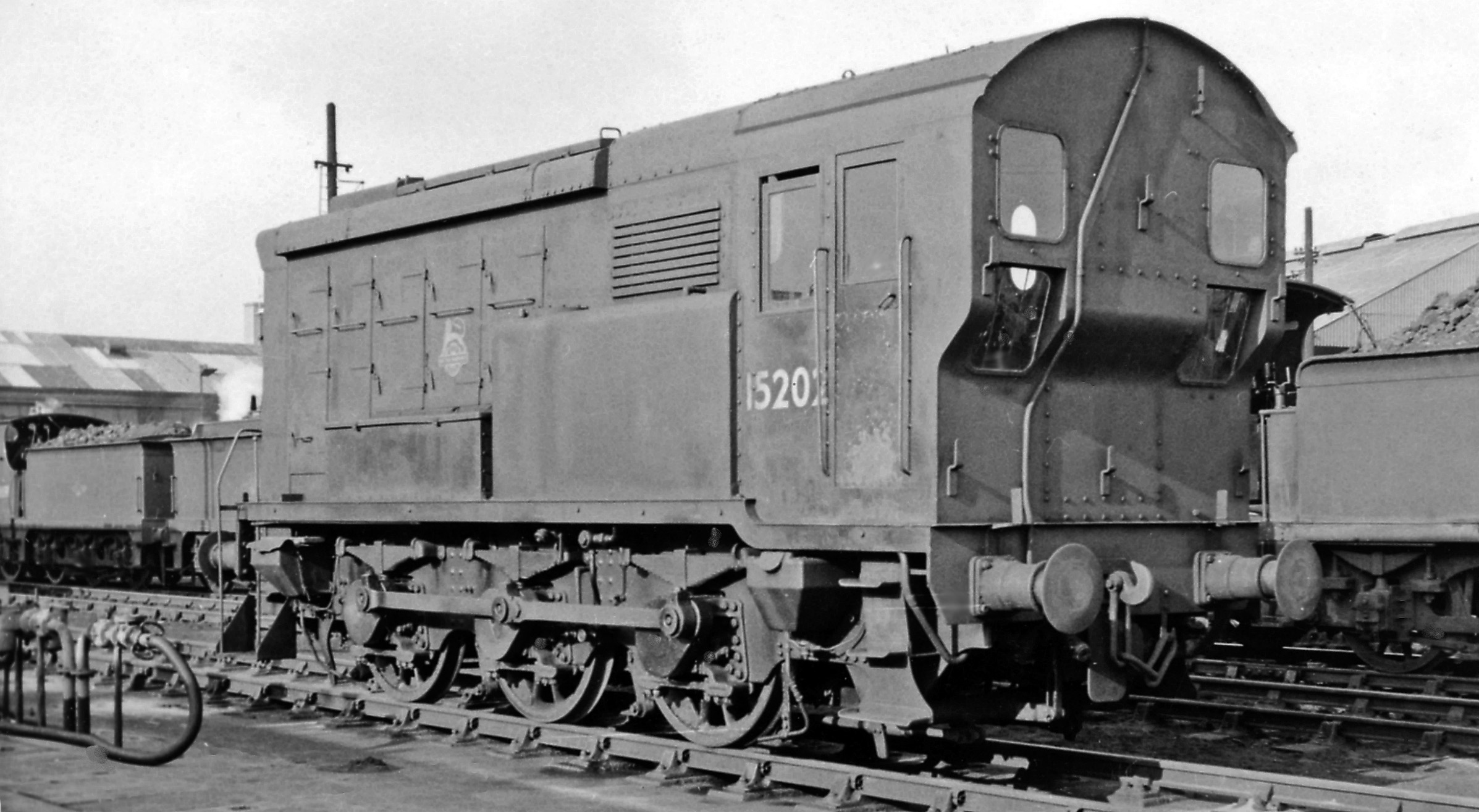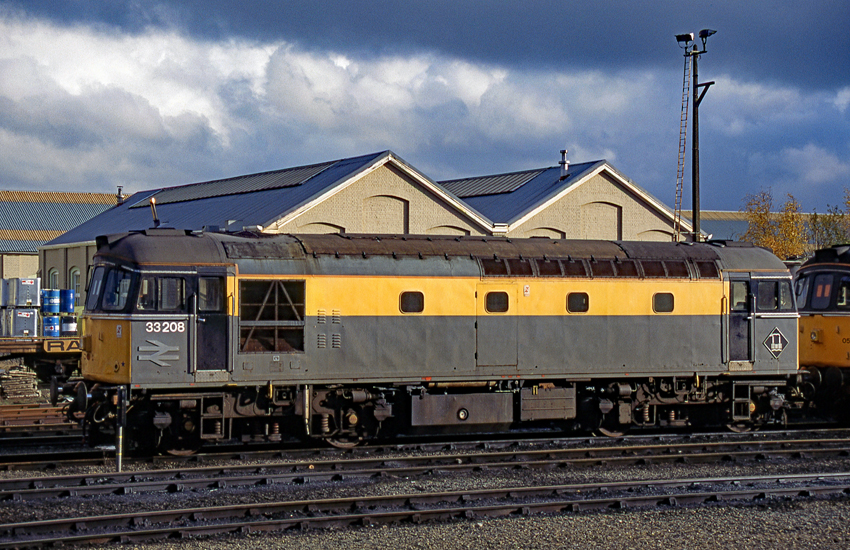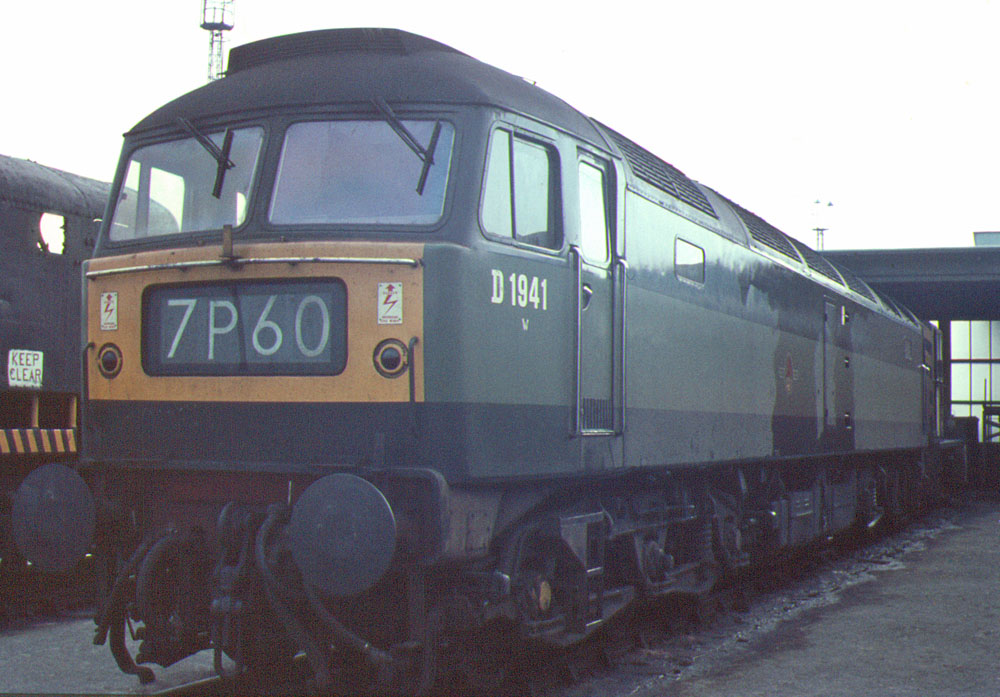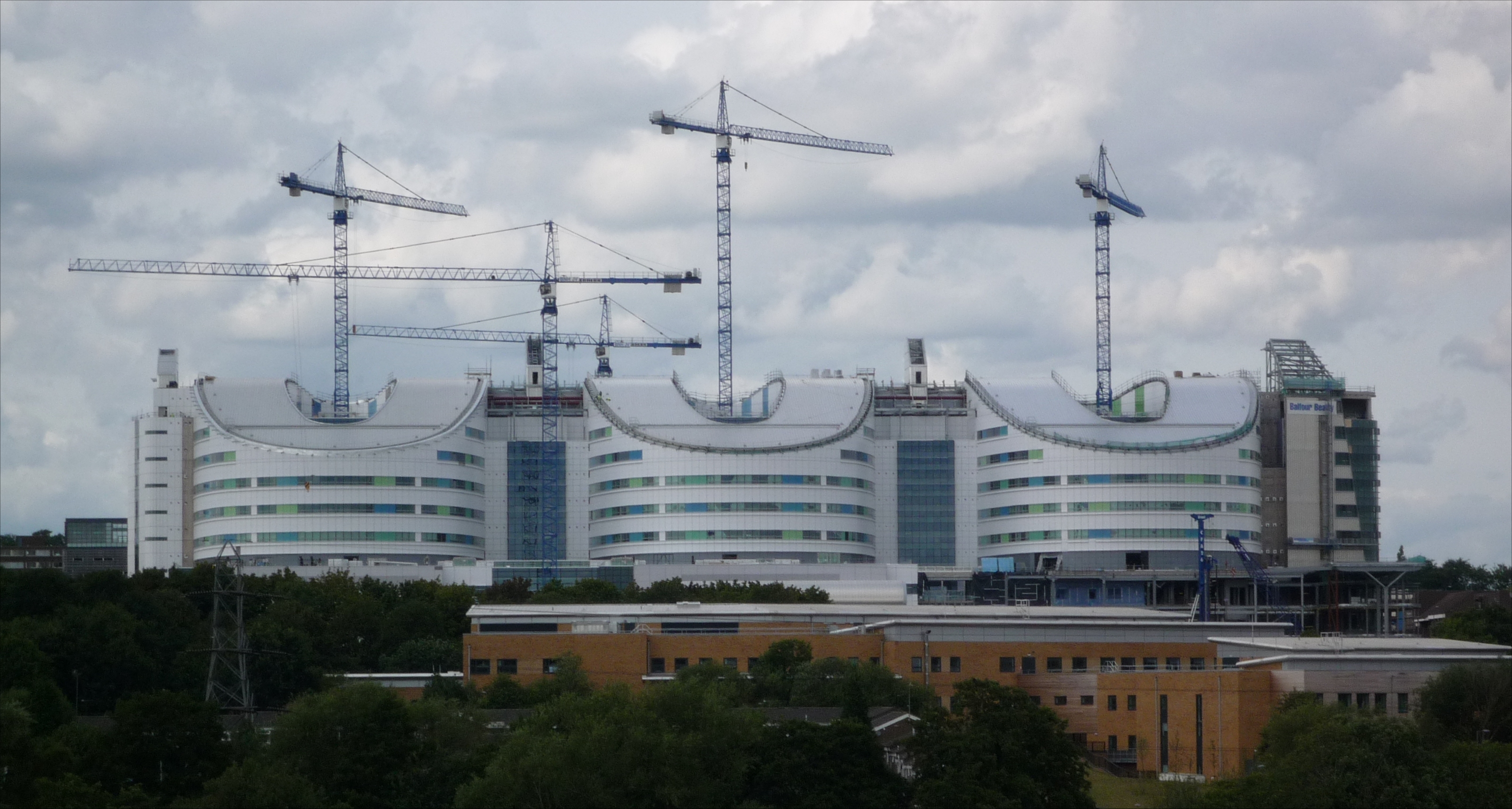|
Hither Green Traction Maintenance Depot (TMD)
Hither Green (London) Traction Maintenance Depot or Hither Green (London) TMD is a railway depot used for the maintenance and servicing of freight trains adjacent to the Hither Green marshalling yard. The depot is a hub for moving freight around southeast England. Hither Green TMD is owned and operated by DBS. The official depot code is HG. In steam days the shed code was 73C. The depot is situated south of Lewisham, to the southeast of Hither Green station between the railway station and Lee station on the Sidcup line and between Hither Green station and Grove Park station on the Orpington line. Motive power depot A modern concrete-fabricated motive power depot was opened by the Southern Railway on 10 September 1933 to service its new marshalling yard at Hither Green. Facilities included a coal stage line and a turntable. It was principally as a freight depot with, responsible for cross-London transfer freights and received a batch of SR W class 2-6-4 tank engines ... [...More Info...] [...Related Items...] OR: [Wikipedia] [Google] [Baidu] |
British Rail Class 33
The British Rail Class 33, also known as the BRCW Type 3 or Crompton, is a class of Bo-Bo diesel-electric locomotives, ordered in 1957 and built for the Southern Region of British Railways between 1960 and 1962. They were produced as a more powerful Type 3 (1,550 bhp) development of the 1,160 bhp Type 2 Class 26. This was achieved, quite simply, by removing the steam heating boiler and fitting a larger 8 cylinder version of the previous 6 cylinder engine. This was possible because of the traffic requirements of the Southern Region: locomotive-hauled passenger traffic depended on seasonal tourist traffic and was heavier in the summer, when carriage heating was not needed. In the winter, their expected use was to be for freight. Thus, they became the most powerful BR Bo-Bo diesel locomotive. The perennially unreliable steam heating boiler could also be avoided. A total of 98 were built by the Birmingham Railway Carriage and Wagon Company (BRCW) and they were known as ... [...More Info...] [...Related Items...] OR: [Wikipedia] [Google] [Baidu] |
Southern Railway (Great Britain)
The Southern Railway (SR), sometimes shortened to 'Southern', was a British railway company established in the 1923 Grouping. It linked London with the Channel ports, South West England, South coast resorts and Kent. The railway was formed by the amalgamation of several smaller railway companies, the largest of which were the London and South Western Railway (LSWR), the London, Brighton and South Coast Railway (LB&SCR) and the South Eastern and Chatham Railway (SE&CR).Bonavia (1987) pp. 26-28 The construction of what was to become the Southern Railway began in 1838 with the opening of the London and Southampton Railway, which was renamed the London & South Western Railway. The railway was noted for its astute use of public relations and a coherent management structure headed by Sir Herbert Walker. At , the Southern Railway was the smallest of the '' Big Four'' railway companies and, unlike the others, the majority of its revenue came from passenger traffic rather than f ... [...More Info...] [...Related Items...] OR: [Wikipedia] [Google] [Baidu] |
British Rail Class 37
The British Rail Class 37 is a diesel-electric locomotive. Also known as the English Electric Type 3, the class was ordered as part of the British Rail modernisation plan. They were numbered in two series, D6600–D6608 and D6700–D6999. The Class 37 became a familiar sight on many parts of the British Rail network, in particular forming the main motive power for InterCity services in East Anglia and within Scotland. They also performed well on secondary and inter-regional services for many years. Many are still in use today on freight, maintenance, and empty stock movement duties. The Class 37s are known to some railway enthusiasts as " tractors", a nickname given due to the similarities between the sound of the Class 37's engine and that of a tractor. Description Background As part of the large scale dieselisation brought about by the British Rail modernisation plan a need was identified for a number of type 3 locomotives of power output to . English Electric had ... [...More Info...] [...Related Items...] OR: [Wikipedia] [Google] [Baidu] |
British Rail Class 31
The British Rail Class 31 diesel locomotives, also known as the Brush Type 2 and previously as Class 30, were built by Brush Traction from 1957-62. They were numbered in two series, D5500-D5699 and D5800-D5862. Construction of the first locomotive was completed in the final week of September 1957, and the handing-over took place on 31 October. The first Class 31 entered service in November 1957, after the launch of the Class 20 locomotive and was one of the Pilot Scheme locomotives ordered by British Railways to replace steam traction. Engines They were originally built with Mirrlees JVS12T (D5500–D5519) and engines and Brush electrical equipment, but the engines were not successful and in 1964 D5677 was fitted with an English Electric 12SVT engine (similar to the 12CSVT used in the Class 37 but without an intercooler) rated at . The trial proved successful, and between 1965 and 1969 the entire class was re-engined. The de-rated engine was used as it was the maximum the e ... [...More Info...] [...Related Items...] OR: [Wikipedia] [Google] [Baidu] |
British Rail Class 25
The British Rail Class 25, also known as the Sulzer Type 2, is a class of 327 diesel locomotives built between 1961 and 1967 for British Rail. They were numbered in two series, D5151-D5299 and D7500-D7677. Background The Class 24 locomotives were the precursor of the Class 25 design but after the delivery of their first few units it became apparent that the speed ceiling of was unduly restrictive and the provision of additional power would be advantageous. In the course of normal development the power output of the Sulzer six-cylinder engine had been increased by to give a continuous traction output of at 750 rpm by the introduction of charge air cooling and the first locomotives to use this became known as Class 25 locomotives. The Class 25 were primarily designed for freight work, but a significant number were fitted with boilers for heating passenger trains. Throughout the 1970s they could be found at work across the whole of the British Rail network although th ... [...More Info...] [...Related Items...] OR: [Wikipedia] [Google] [Baidu] |
British Rail Class 56
The British Rail Class 56 is a type of diesel locomotive designed for heavy freight work. It is a Type 5 locomotive, with a Ruston-Paxman power unit developing 3,250 bhp (2,423 kW), and has a Co-Co wheel arrangement. Enthusiasts nicknamed them "Gridirons" (or "Grids" for short), due to the grid-like horn cover on the locomotive's cab ends fitted to nos. 56056 onwards. Under its Romanian railway factory nomenclature, the locomotive was named Electroputere LDE 3500, with LDE coming from ''Locomotivă Diesel-Electrică'' (Diesel-Electric Locomotive) and the 3500 being the planned horsepower output. The Class 56 fleet was introduced between 1976 and 1984, a total of 135 examples were manufactured. The first 30 locomotives (56001 - 56030, factory classification LDE3500) were built by Electroputere in Romania, but these typically suffered from poor construction standards and many were withdrawn from service early for extensive rebuilding before re-entering revenue service. The re ... [...More Info...] [...Related Items...] OR: [Wikipedia] [Google] [Baidu] |
British Rail Class 47
The British Rail Class 47 or Brush Type 4 is a class of diesel-electric locomotive that was developed in the 1960s by Brush Traction. A total of 512 Class 47s were built at Brush's Falcon Works in Loughborough and at British Railways' Crewe Works between 1962 and 1968, which made them the most numerous class of British mainline diesel locomotive. They were fitted with the Sulzer 12LDA28C twin-bank twelve-cylinder unit producing though this was later derated to to improve reliabilityand have been used on both passenger and freight trains on Britain's railways for over 55 years. Despite the introduction of more modern types of traction, a significant number are still in use, both on the mainline and on heritage railways. As of December 2021, 78 locomotives still exist as Class 47s, including 31 which have been preserved. 33 further locomotives were converted to Class 57s between 1998 and 2004. Origins The Class 47 history begins in the early 1960s with the stated aim of t ... [...More Info...] [...Related Items...] OR: [Wikipedia] [Google] [Baidu] |
British Rail Class 73
The British Rail Class 73 is a British electro-diesel locomotive. The type is unusual in that it can operate from the Southern Region's 650/750 V DC third-rail or an on-board diesel engine to allow it to operate on non-electrified routes. This makes it very versatile, although the diesel engine produces less power than is available from the third-rail supply so the locomotives are rarely operated outside of the former Southern Region of British Rail. Following the withdrawal and scrapping of the more powerful Class 74 electro-diesels in 1977, the Class 73 was unique on the British railway network until the introduction of the Class 88 electro-diesels in 2017. Ten locomotives have been scrapped. History The Southern Railway's expanding third rail electric passenger network (which had begun as far back as 1915) was until 1941 a purely passenger electric multiple unit (EMU) system. This was because it was necessary to have gaps in the third rail for level crossings, etc., w ... [...More Info...] [...Related Items...] OR: [Wikipedia] [Google] [Baidu] |
Eastleigh
Eastleigh is a town in Hampshire, England, between Southampton and Winchester. It is the largest town and the administrative seat of the Borough of Eastleigh, with a population of 24,011 at the 2011 census. The town lies on the River Itchen, one of England's premier chalk streams for fly fishing, and a designated site of Special Scientific Interest. The area was originally villages until the 19th century, when Eastleigh was developed as a railway town by the London and South-Western Railway. History The modern town of Eastleigh lies on the old Roman road, built in A.D.79 between Winchester ''( Venta Belgarum)'' and Bitterne ''(Clausentum)''. Nicola Gosling: 1986, Page 4 Roman remains discovered in the Eastleigh area, including a Roman lead coffin excavated in 1908, indicate that a settlement probably existed here in Roman times. A Saxon village called 'East Leah' has been recorded to have existed since 932 AD. ('Leah' is an ancient Anglo-Saxon word meaning 'a clearing ... [...More Info...] [...Related Items...] OR: [Wikipedia] [Google] [Baidu] |
Balfour Beatty
Balfour Beatty plc () is an international infrastructure group based in the United Kingdom with capabilities in construction services, support services and infrastructure investments. A constituent of the FTSE 250 Index, Balfour Beatty works across the UK, US and Hong Kong. By turnover, Balfour Beatty was ranked in 2021 as the biggest construction contractor in the United Kingdom. History Early years Balfour Beatty was formed in 1909, with a capital of £50,000. The two principals were George Balfour, a qualified mechanical and electrical engineer, and Andrew Beatty, an accountant. The two had met while working for the London branch of the New York engineers JG White & Company. Initially, the company concentrated on tramways, the first contract being to construct the Dunfermline and District Tramways that opened in November 1909 for Balfour Beatty's own subsidiary, the Fife Tramway Light and Power Company. It subsequently acquired a portfolio of electric power and tramway com ... [...More Info...] [...Related Items...] OR: [Wikipedia] [Google] [Baidu] |
Railfreight
Railfreight was a sector of British Rail responsible for all freight operations on the British network. The division was created in 1982 when BR sought to assign particular stock and management to the evolving requirements of freight traffic. History Railfreight existed as a single unit from 1982 until 1987 as the rail freight division of British Rail. In 1987 BRs freight operations were further divided according to the type of train operated and material carried; the Trainload Freight division and its sub-sectors handled unit trains of coal, metal, aggregates, oil or petroleum, LPG, petro-chemicals, and construction materials, Railfreight Distribution handled intermodal and non-unit train work, and channel tunnel freight. Activities which were not assigned to one of the new ''Trainload Freight'' or ''Railfreight Distribution'' sub-sectors were then continued under the Railfreight General banner, Railfreight General was dissolved in 1989, its limited responsibilities being ... [...More Info...] [...Related Items...] OR: [Wikipedia] [Google] [Baidu] |
Traction Maintenance Depot
The motive power depot (MPD) or locomotive depot, or traction maintenance depot (TMD), is the place where locomotives are usually housed, repaired and maintained when not being used. They were originally known as "running sheds", "engine sheds" or, for short, just sheds. Facilities are provided for refuelling and replenishing water, lubricating oil and grease and, for steam engines, disposal of the ash. There are often workshops for day to day repairs and maintenance, although locomotive building and major overhauls are usually carried out in the locomotive works. (Note: In American English, the term ''depot'' is used to refer to passenger stations or goods (freight) facilities and not to vehicle maintenance facilities.) German practice The equivalent of such depots in German-speaking countries is the ''Bahnbetriebswerk'' or ''Bw'' which has similar functions, with major repairs and overhauls being carried out at '' Ausbesserungswerke''. The number of these reduced drastic ... [...More Info...] [...Related Items...] OR: [Wikipedia] [Google] [Baidu] |




.jpg)





